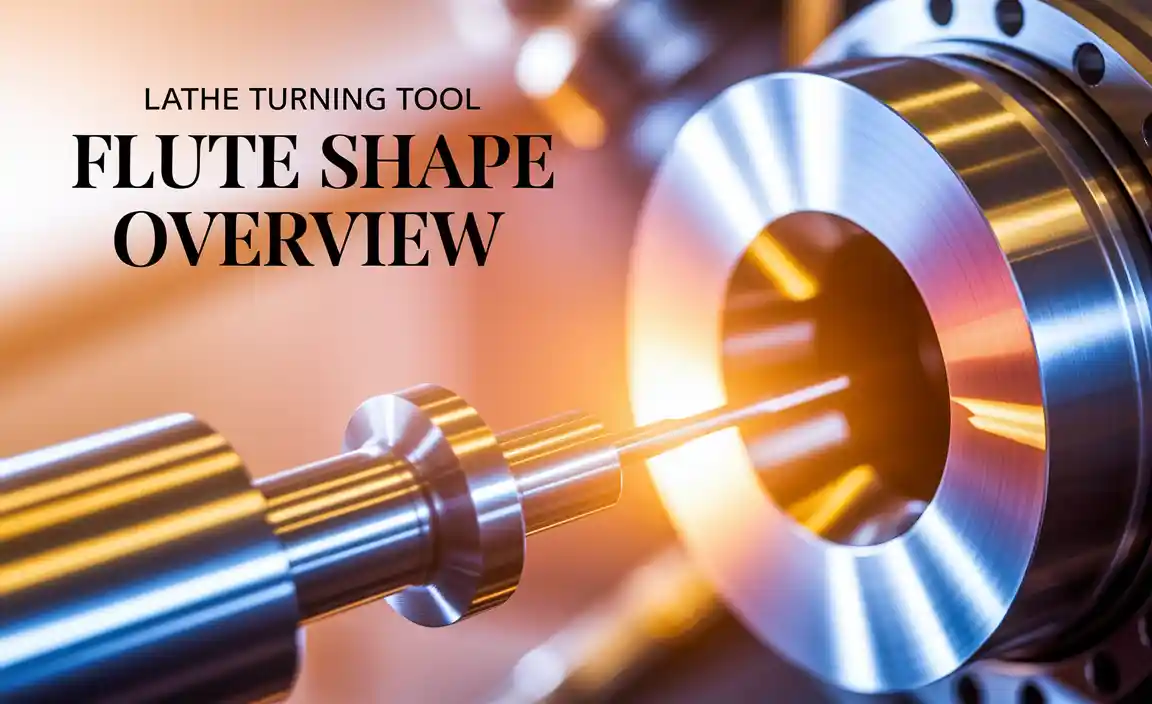Quick Summary: The TiALN ball nose end mill, especially with a 35-degree helix, is crucial for safely and effectively machining small pockets in carbon steel. Its specialized shape and coating prevent premature wear, allow for smooth material removal, and ensure accurate finishes, making it a go-to tool for detailed machining tasks.
Hey makers! Daniel here from Lathe Hub. Ever found yourself staring at a complex part with tiny, intricate pockets and wondering how on earth you’re going to machine them without breaking your tool or ruining your workpiece? It’s a common challenge, especially when working with tough materials like carbon steel. Many standard end mills just don’t have the right geometry or wear resistance for these delicate jobs. But don’t worry, there’s a tool specifically designed for this: the ball nose end mill. And when you add a TiALN coating to that? You’ve got a powerhouse for small pockets. In this guide, we’ll break down exactly why this tool is your new best friend for precision machining.
Why Small Pockets Are Tricky
Machining small pockets presents a unique set of challenges that can quickly turn a simple job into a frustrating one. Think about it: you need to get into tight spaces, remove material precisely, and avoid crashing into the surrounding walls. This is especially true when you’re working with materials like carbon steel, which can be prone to chipping, excessive heat, and rapid tool wear.
Here’s why they’re so tricky:
- Limited Clearance: The walls of your pocket are often very close to the cutting edges of your tool. This means any wobble or inaccuracy in your tool or setup can lead to expensive mistakes.
- Heat Buildup: Smaller diameters mean less surface area to dissipate heat. Small pockets often require multiple passes, and without proper cooling or tool coatings, heat can quickly ruin your tool and the workpiece.
- Chip Evacuation: In confined spaces, chips can get trapped. If not cleared properly, these chips can recut, leading to a poor surface finish, tool breakage, or workpiece damage.
- Tool Wear: The constant contact and potential for heat and chip binding accelerate wear on standard end mills, especially in hard materials like carbon steel.
Standard end mills, with their flat bottoms and sharp corners, aren’t ideal for these situations. Their sharp corners can create stress points, leading to chipping. Their flat bottoms make it impossible to create rounded internal corners, which is often a requirement for strength and stress reduction. This is where a specialized tool becomes not just helpful, but essential.
Enter the Ball Nose End Mill
So, what makes a ball nose end mill so special for these tight spots? The name gives it away! Unlike a standard end mill which has a flat cutting face, a ball nose end mill has a semicircular or perfectly radiused tip. Imagine a ball shape, and you’ve got the general idea of its cutting end.
This unique shape offers several advantages:
- Rounded Internal Corners: The most significant benefit is its ability to create beautiful, smooth, radiused internal corners. This is critical for stress concentration reduction in parts. Think of aircraft components or intricate mold designs; these rounded corners are often a design requirement for structural integrity.
- Smooth Surface Finish: The continuous curvature of the cutting edge allows for smoother engagement with the material, leading to a superior surface finish compared to the potentially scalloped or rougher finish left by flat-bottomed end mills plunging or ramping.
- Varied Cutting Strategies: Ball nose end mills are fantastic for 3D contouring, surfacing, and performing roughing and finishing passes in complex geometries.
However, not all ball nose end mills are created equal, especially when you’re targeting specific materials.
The Magic of TiALN Coating
Now, let’s talk about that “TiALN” – Titanium Aluminum Nitride. This isn’t just a fancy color; it’s a high-performance coating that dramatically enhances the capabilities of an end mill, particularly for demanding materials like carbon steel. When you combine this coating with a ball nose profile, you get a tool that’s exceptionally well-suited for machining those tricky small pockets.
Here’s what TiALN brings to the table:
- Extreme Hardness: TiALN is incredibly hard, which means it resists wear exceptionally well. This is vital for carbon steel, as it can be abrasive and tough on cutting edges.
- High-Temperature Resistance: One of the biggest enemies of cutting tools is heat. TiALN forms a protective aluminum oxide layer at high temperatures, helping to keep the cutting edge sharp and preventing it from softening. This means longer tool life and better performance, especially in demanding cuts.
- Reduced Friction: The coating lowers the friction between the tool and the workpiece. This leads to less heat generation, better chip flow, and a smoother cutting action.
- Dry Machining Capabilities: Good TiALN coatings can often allow for machining with minimal or even no coolant, which can be a significant advantage in some workshop environments and for certain materials.
When you’re machining small pockets in carbon steel, you’re often dealing with high localized heat. The TiALN coating acts like a heat shield for your cutting edges, allowing you to push the tool a bit harder and achieve better results without rapid degradation.
The Importance of a 35-Degree Helix Angle
Within the realm of ball nose end mills, you’ll find different helix angles. For machining smaller pockets in materials like carbon steel, a 35-degree helix angle is often a sweet spot. What is a helix angle? It’s essentially the angle of the flutes (the spiral grooves) around the tool shank. For ball nose end mills, this angle plays a crucial role in how the tool engages with the material.
A 35-degree helix angle offers a good balance for applications like pocketing:
- Reduced Chatter: Flutes that are steeper (higher helix angle) can sometimes lead to vibration or chatter, especially in lighter machines or during light cuts. A 35-degree helix is generally considered a good compromise, offering decent cutting action without being overly prone to chatter.
- Good Chip Evacuation: The 35-degree angle helps in spiraling chips away from the cutting zone. This is critical in small pockets where chip buildup can quickly become a problem, leading to re-cutting and poor surface finish.
- Axial Rake: The helix angle influences the effective rake angle of the cutting edge. A 35-degree helix often provides a geometry that works well for materials like carbon steel, allowing for efficient material removal.
- Stiffness and Strength: Shorter flutes (which often correspond to lower helix angles) can be stiffer, but the 35-degree angle offers a good balance between flute length for cutting and overall tool rigidity, crucial for accurate pocketing.
While you might see tools with 30-degree or even 45-degree helix angles, the 35-degree is frequently recommended for its versatility and ability to handle a range of carbon steels and pocketing operations. Tools with a near-zero helix (straight flute) are generally not suitable for machining pockets as they offer poor chip evacuation and can lead to tool binding.
Choosing the Right TiALN Ball Nose End Mill for Small Pockets
Now that you understand the components – the ball nose shape, the TiALN coating, and the 35-degree helix – let’s talk about selecting the right tool for your specific needs. It’s not just grabbing the first one you see!
Consider these factors when making your choice:
1. Diameter
This is perhaps the most critical factor. The diameter of your ball nose end mill will directly dictate the smallest radius you can create in your pocket. For example, to create a radius of 2mm internally, you need a ball nose end mill with a 4mm diameter. Always measure the smallest internal radius required in your design and select a tool that matches or is slightly larger if feasible.
2. Flute Count
Ball nose end mills come in various flute counts (e.g., 2-flute, 3-flute, 4-flute).
- 2-Flute: Generally offers the best chip clearance, making it ideal for softer materials or when you need to maximize chip evacuation in tight spaces. They can also be run at higher feed rates.
- 3-Flute: Offers a good balance between chip clearance and tool rigidity. It can handle a wider range of materials and cutting strategies.
- 4-Flute: Provides excellent rigidity and a smoother finish, but can have poorer chip clearance. They are often preferred for aluminum or high-speed finishing passes where chip evacuation is less of an issue or can be managed with coolant.
For small pockets in carbon steel, a 2-flute or 3-flute TiALN ball nose end mill is typically recommended. The extra flute clearance from a 2-flute can be a lifesaver in preventing chip recutting in confined areas.
3. Overall Length and Neck Relief
When machining deep pockets, the overall length of the tool and whether it has a neck relief are crucial. A neck relief is a slight diameter reduction behind the cutting flutes. This allows the tool to access deeper features without the flutes rubbing against the sides of the pocket. For small, shallow pockets, this might not be as critical, but for anything with depth, it’s a consideration.
Always ensure your tool is long enough to reach the bottom of your pocket comfortably, but not so long that it becomes overly flexible.
4. Material of the End Mill Itself
While the TiALN coating is key, the base material of the end mill also matters. Most performance end mills are made from solid carbide. Carbide is extremely hard and rigid, making it capable of withstanding the forces involved in machining steel. Ensure you are selecting a solid carbide ball nose end mill.
5. Manufacturer and Quality
Not all tools are made equal! Reputable tool manufacturers invest in better materials, tighter tolerances, and superior coating processes. Investing in a quality tool from a known brand is often more cost-effective in the long run due to its performance and lifespan.
A good starting point for carbon steel pocketing would be a 2-flute or 3-flute solid carbide, TiALN coated, ball nose end mill with a 35-degree helix angle. The diameter will be dictated by your pocket’s geometry.
Machining Pointers: Making it Work in the Shop
Having the right tool is only half the battle. Here are some tips to ensure you get the best results when using your TiALN ball nose end mill for small pockets:
1. Feeds and Speeds
This is where experience and good data come in. Always consult your machine’s manuals or manufacturer’s recommendations. For carbon steel, you’ll typically need lower spindle speeds and moderate feed rates compared to softer materials like aluminum. The TiALN coating allows for higher cutting speeds than uncoated carbide, but it’s still a robust material.
A good starting point for a 4mm diameter, 35-degree helix, 2-flute TiALN ball nose end mill in medium carbon steel (like 1045) might look something like this (these are rough examples and MUST be adjusted based on your specific material, machine rigidity, and tool manufacturer’s recommendations):
- Spindle Speed: 8,000 – 12,000 RPM
- Feed Rate: 0.001 – 0.002 inches per tooth (ipt)
- Depth of Cut: 0.050 – 0.100 inches (radial), 0.010 – 0.020 inches (axial) for finishing. Roughing would involve larger axial depths.
It’s often better to start conservatively and increase your feed rate until you hear the tool singing rather than screaming. You can find excellent resources for calculating feeds and speeds online. For example, MachineryParts.com offers a useful calculator that can help you get in the ballpark.
2. Toolpath Strategy
For small pockets, you’ll likely use these strategies:
- Ramp Plunging: Instead of plunging straight down (which puts immense stress on the tool), ramp into the material at an angle (e.g., 3-5 degrees). The ball nose geometry helps with this.
- Helical Interpolation: This is similar to ramping. The tool moves in a spiral motion to enter the material.
- 3D Contour/Pocketing: Modern CAM software excels at creating complex 3D toolpaths that use the ball nose’s spherical shape to leave a smooth, consistent surface.
- Finishing Passes: For a truly pristine finish, a final, shallow finishing pass with a small stepover (the distance the tool moves sideways between passes) is crucial.
3. Coolant and Lubrication
While TiALN coatings improve dry machining, a little bit of coolant or a suitable cutting fluid can significantly enhance tool life and surface finish, especially in carbon steel. Use a flood coolant system if available, or a spray mist coolant system for better chip control and cooling. For manual machining, a good quality cutting fluid applied directly to the cutting edge is a must.
CarbideProcessors.com has a great selection of machining fluids that can help you find the right product.
4. Workholding and Rigidity
Ensure your workpiece is securely held. Any movement of the workpiece or tool during the cut will degrade the finish and can break the tool. A rigid setup is paramount for accurate machining. Avoid long, unsupported tool holders if possible, and ensure your machine’s spindle is in good condition.
5. Chip Evacuation Management
Even with a 2-flute tool and good helix, chips can build up. If you see chips accumulating or re-cutting, pause your program, retract the tool slightly, and use a brush or compressed air (carefully!) to clear the chips. In automated CNC operations, you might need to incorporate small retract moves or air blasts into your CAM program.
When to Use a Ball Nose vs. Other End Mills
It’s important to know when the ball nose is the right tool. Here’s a quick comparison:
| Tool Type | Primary Use Cases | Pros for Small Pockets | Cons for Small Pockets |
|---|---|---|---|
| Ball Nose End Mill | 3D contouring, surfacing, radiused internal corners, complex molds | Creates perfect internal radii; excellent for smooth finishes; good for creating contoured surfaces. | Cannot create sharp internal corners; often requires more sophisticated CAM if generating Z-level toolpaths. |
| Square End Mill | Slotting, pocketing with square corners, general milling | Can create square internal corners (requires EDM for sharp internal corners); fast material removal in open areas. | Cannot create radii; sharp bottom corners can be stress risers; challenging for tight radii and precise internal corners. |
| Corner Radiused End Mill | Pocketing with consistent internal radii, some parting operations | Creates a consistent radius in corners; more robust than a square end mill for certain operations. | Radius is built-in, limiting flexibility; still cannot create perfectly sharp corners; can be less efficient for full pocketing than a ball nose. |
For small pockets where internal radii are either required for design integrity or simply unavoidable due to the tool’s geometry, the ball nose end mill is the undisputed champion. If you need truly sharp internal corners (which are rare due to stress concentration), you’d typically need to employ Electrical Discharge Machining (EDM) after milling, or accept a slight radius left by a square end mill.
Safety First!
Working with any cutting tool, especially in a CNC environment or with hand tools, demands attention to safety. Always:
- Wear appropriate personal protective equipment (PPE), including safety glasses that offer full coverage and sturdy work gloves.
- Ensure your workpiece is securely fixtured.
- Understand your machine’s capabilities and limitations.
- Never force a tool; if it’s struggling, stop, back out, and reassess your feeds, speeds, or depth of cut.
- Keep your work area clean and free of debris.
- Familiarize yourself with emergency stop procedures for your machine.
The U.S. Occupational Safety and Health Administration (OSHA) provides extensive resources on workplace safety, which are invaluable for anyone working with machinery. You can find general safety guidelines on their <a href="https://



